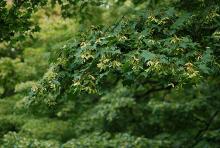Acer pictum
Common name:
Painted Maple
Pronunciation:
A-ser PIK-tum
Family:
Sapindaceae, Aceraceae
Genus:
Synonyms:
Acer mono
Type:
Broadleaf
Native to (or naturalized in) Oregon:
No
- Broadleaf deciduous tree, to 40-60(90) ft [12-18(27) m] tall, rounded spreading crown, twigs glabrous to sparsely hairy, green to olive-brown to reddish-brown. Bark at first is smooth, gray, with irregular shallow, vertical fissures with age. Leaves opposite, simple, 8-15 cm wide, 5-7 triangular lobes, to middle or shallowly lobed (highly variable), base somewhat heart-shaped (cordate), margin entire but occasionally with a few large teeth, the upper surface is mid-green and glabrous, the lower surface lighter green with prominent veins, brownish hairs on the main veins; fall color from yellow to gold with reddish to purplish bronzing; the petiole is slender and as long as the blade and contains a milky sap (seen upon its separation from the stem). Flowers greenish yellow, appear with the leaves, in 4-6 cm long and wide clusters (corymbs), the flowers are male or female with 5 petals and 5 sepals and 8 stamens. Fruit (samaras) are in horizontal to upright clusters, each pair are usually wide spreading, but the angle can vary from horizontal to parallel or even overlapping.
- Sun or light shade
- Hardy to USDA Zone (4) 5 Native to a vast area of eastern Asia, from Tibet and throughout central and northern China to southeastern Siberia, Korea, and the main islands of Japan. Because of its large natural distribution, numerous forms, varieties and supspecies have been named, mostly based on leaf characteristics, and a lesser degree on bark and fruit [Gregory, P. 2009, The Maple Society Newsletter. 19(2):12-17.].
- The nomenclature story: In August 1784 the Swedish botanist, Carl Peter Thunberg, published Flora Japonica which contained a description of a plant which he named Acer pictum. The description, however, was apparently based on a limited herberium specimen which did not contain leaves or fruit. However, that plant was not even an Acer but in the family Araliaceae, which mostly consists of tropical trees and shrubs. The mistake was realized and he re-named the plant Kalopanax pictus, now commonly known at the Castor-aralia. Thunberg then argued that Acer pictum was thus an illegitimate name and since the Russian botanist, Carl Maximowicz, had described the maple in 1847, 64 years later, under the name Acer mono, this was the correct name. This view was generally accepted for a long time. However, in 1993 Hiroyoshi Ohashi [J. Japanese Botany 68(6):317] pointed out that Johann A. Murry, a German botanist, in June 1784 and Carl Thunberg in August 1784 had given full idential descriptions of the maple under the name Acer pictum. The descriptions were based on herbarium material collected by Thunberg on a Japanese expedition in 1775-6. Thunberg's description of the Araliaceae plant was "not authentically published" until December 1784/January 1785, some 6-8 months later. This information then gave precedence for Acer pictum as being the correct name for the painted maple.
- pictum: painted; brightly colored.








